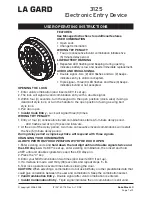
TCG140_R1.1 – May 2018
Page 25
7.3.2.
Logger
This section is for logger setup.
The logger works in three modes – Time, Alarm and Time&Alarm. The mode specifies what
initiates a record in the logger’s memory. In Time mode, records are made periodically on “Log
interval” time. In Alarm mode, records are made on every alarm condition. In Time&Alarm mode,
a mix of both conditions for records is used. To be used the logger should be enabled. By default,
it is disabled.
There are two ways to reach the logger records:
download of the full log file, using “Download full log” in the WEB interface
;
periodical upload the last unsent records to the dedicated HTTP server.
The records are uploaded in CSV file format. The period of upload can be chosen from menu between
1 and 24 hours.
The HTTP server can be addressed either by domain name or IP address.
“Sync time” is a moment in the day when a period of upload is synchronized.
Example:
Current time is 19:31, Upload period is 3 hours and Sync time is 9:00.
To synchronize the logger to 9:00 it means that time for uploads will be:
09:00
, 12:00, 15:00,
18:00, 21:00, 24:00, 03:00 and 06:00. The first upload, after enabling the logger in 19:31, will be in
21:00.
The button “Force upload” initiates upload recorded information between previous periodical upload
and now.
By default HTTP upload of logger data is disabled. If you enable this service take care of the real-time
clock (NTP service).
More about the logger can be found in Data logger section.
7.3.3.
HTTP Post
HTTP Post is used for periodically upload an XML/JSON file to HTTP server by HTTP requests
(POST method). The XML/JSON file contains current status of all monitored parameters and extra
system information. The file format is chosen from the drop-down menu.
Summary of Contents for TCG140
Page 1: ......
Page 47: ...TCG140_R1 1 May 2018 Page 47 Appendix C Fig 1 Fig 2 ...
















































